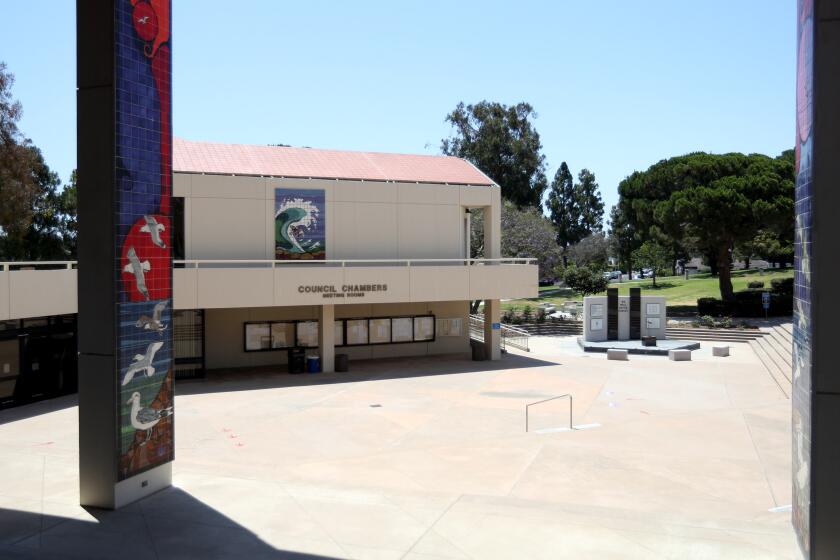NATURAL PERSPECTIVES:Refreshing our souls in the wilds of Yosemite
- Share via
We love Huntington Beach, Bolsa Chica and Central Park. But sometimes we need to get away from our familiar surroundings to refresh our perspective of nature. Last week, Vic and I headed off to Yosemite National Park. We’ve returned refreshed and renewed.
There is something about the majestic grandeur of Yosemite that makes every photographer yearn to take pictures like those of Ansel Adams. But the amazing thing about Yosemite isn’t its natural features. It’s how their appearance changes with the light, weather and the seasons. You can never see Yosemite the same way twice.
We go there nearly every year, either to the east side in summer or the west side in winter. I never tire of the scenery, nor of trying to capture Yosemite’s surreal and splendid beauty with a camera.
But sometimes the reality of environmental issues crept into our vacation. For example, we noticed that little snow remained in the southern Sierras. It’s been a dry winter there, which doesn’t bode well for the Sierra snowpack and our local drinking water supply.
Another concern is that global climate change is causing spring to come earlier. Even in mid-February, the snowmelt was cascading off cliffs and into creeks. As the climate continues to warm, late winter and early spring moisture will fall as rain rather than snow, which will run off rapidly rather than melt slowly over the course of summer. The dams can’t hold all of the early runoff, and valuable drinking and farm irrigation water is released into the streams instead of being held.
Vic and I discussed these serious issues on our drive, but environmental realities didn’t interfere with our enjoyment of the scenery. As usual, Yosemite captivated us with its beauty as we rounded a corner and spotted Bridal Veil Falls. We found trout in the river, gray squirrels scampering up trees, and a small group of mule deer browsing on twigs.
As we were leaving the valley on our last evening there, the light of the setting sun played off the sheer vertical wall of El Capitan, setting it aglow. The reflection bounced off the rock face and onto the silvery surface of the Merced River, sending shimmers of liquid gold coursing from bank to bank.
I bounced from rock to rock in the Merced, trying to line up a shot that caught a shimmering reflection of El Capitan in a bend in the river. Somehow I always fail to totally capture Yosemite’s grandeur in the camera. Pictures are a poor and partial reminder of the 360-degree experience. Maybe that’s why we keep going back. Those towering rock walls need to be enjoyed by a total immersion experience, not viewed second-hand from a photograph. Still, I couldn’t help but take pictures. Hope springs eternal that one of them will manage to capture the feeling of being there. Just like hope springs eternal that humans will be able to solve this planet’s environmental crises.
While I was composing pictures, Vic studied a pair of dippers in the river. These interesting little birds make their living by walking and swimming underwater in frigid mountain streams, searching for insects. As the darkness descended on the valley, we wended our way down the mountain past the Wawona Hotel to Tenaya Lodge where we were staying just outside the park’s south entrance.
The lodge changed management about three years ago and has greatly improved in several ways. We especially appreciated the Delaware North Companies’ pro-environment management philosophy. All room lights had been changed to low-wattage fluorescent bulbs, with water-saving fixtures in the bathrooms. Outdoor lighting had been reduced to prevent “bleed” of light into the surrounding natural area to enhance star-gazing opportunities. But we noticed the new environmental consciousness most in the hotel’s Sierra Restaurant.
We had a terrific dinner there that included an informative discussion with sous chef Dwayne McFann when he stopped by our table. He explained to us how they search for locally grown, organic foods whenever they are available. Choosing organic produce promotes the health of the environment by reducing the amounts of herbicide and pesticide that are sprayed. Choosing locally grown foods reduces carbon emissions because less trucking is needed to get the food from farm to table.
The Sierra Restaurant even had an “organic and sustainable” section on the menu, using the Monterey Bay Aquarium’s seafood watch list as a guideline for which seafood to serve and which to avoid. The world’s fisheries are being fished out in many places, with species like orange roughy, red snapper and Chilean sea bass in rapid decline. They don’t serve these “watch-listed” species at Tenaya, but opt instead for sustainable species such as Alaskan halibut. You can learn more about choosing sustainable seafood at www.mbayaq.org/cr/seafood watch.asp.
One key to choosing environmentally responsible seafood is knowing where and how the fish or shellfish were farmed or caught. Not all farmed fish are raised in environmentally friendly ways. For example, tilapia are raised in the U.S. in an environmentally responsible manner, but not so in China and Taiwan. Also, the seafood watch list recommends wild-caught Alaskan salmon, but not farm-raised salmon, no matter where it is raised.
We really hated to come back home, but vacations don’t last forever. This getaway helped us renew our commitment to eat sustainable seafood, and buy locally grown, organic produce as much as possible.
All the latest on Orange County from Orange County.
Get our free TimesOC newsletter.
You may occasionally receive promotional content from the Daily Pilot.







